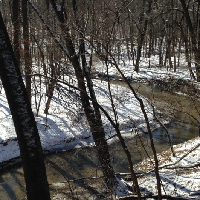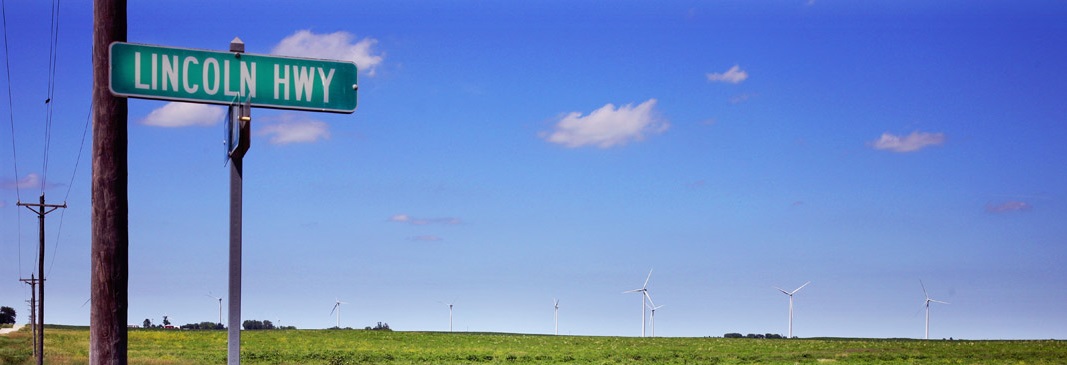
by Dan Haug | Mar 1, 2017
March 1, 2017
I spent Sunday hiking along Clear Creek in the company of a curious herd of six deer, who came within 20 feet of me. Bigger rivers may afford more opportunities for boating. Cold-water trout streams in the northeast part of the state may have better fishing. But the warm-water creeks in Central Iowa have their own charms.

Deer by Clear Creek in Munn Woods
Clear Creek starts in Boone County and passes through Munn Woods and Pammel Woods in Ames before joining Squaw Creek. As a boy, the woods along this creek was one of my favorite places, full of interesting rocks and animal tracks and birds and crayfish, the site of both noisy stick battles with my friends and quiet contemplation.
As my environmental consciousness grew, I would go to the woods to pick up litter. At the time, I had no idea the storm drain emptied to creek, or else I would have stopped my friends from throwing pop cans down there. A recent survey showed that 37% of Iowans imagine that storm sewers go to the wastewater treatment plan or soak into the ground, so labels like this one below are a valuable reminder.

Labeled storm drain in Ames: “No Dumping. Drains to Creek”
In revisiting Clear Creek, I was struck by what a marvelous thing a creek can be if given some space to roam. (Thank you Iowa Natural Heritage Foundation.) I’ve heard from many people in both the city and the country who share my fond memories of time spent by the creek near where they grew up. Not every Iowa creek has hills and woods this dramatic, but if we treat them as something more than drainage systems for our convenience, any local creek can instill in a child the same sense of wonder and discovery that this one did for me.
-Dan Haug, Watershed Educator

Clear Creek meanders through Munn Woods
by Janice Gammon | Feb 4, 2015
I live just off the Lincoln Highway Byway and travel on it daily. But how well do I know this important piece of history?
There was this new invention- the automobile- being produced and auto makers really wanted to sell their inventions. They needed roads for traveling and thought it would be pretty neat for cars to travel east and west across the entire nation. The Lincoln Highway began in 1913 as an assortment of existing wagon roads, turnpikes, and trails. The road started in Times Square in New York and ended in San Francisco, California.
The Iowa portion was dictated in part by how to cross two rivers- the Missouri on the west and the Mighty Mississippi on the east. Good bridges were identified in Clinton and Council Bluffs and “good roads” were sought to connect these two points. This often proved to be a challenge, because much of Iowa was boggy, spongy soil and roads often turned to mud. Iowa has many creeks and rivers to cross. But roads did exist as farmers needed to not only get supplies to their farms but their produce to market. These farm to market roads often led to railroad stations.
The original national plan for the Lincoln Highway was to create a “seedling” mile in each state. A mile stretch would be paved to show citizens and travelers how traveling could be improved with paved roads. Iowa’s “seedling” mile is just east of Cedar Rapids. Greene County also applied for federal aid to pave 6 1/2 miles extending equal distances from the county seat of Jefferson. These were the only paved portions in Iowa until 1924. As neighboring roads were improved, the alignment (route) changed. Maybe a mile or two north or south was in better shape or a better bridge was built. In 1920, a red, white, and blue band was painted on poles, fence posts, and rocks to show the traveler which way to go. On September 1, 1928, Boy Scout troops installed 3,000 concrete markers with bronze medallions at planned locations about one mile apart. Many of these markers no longer exist due to road construction, theft, and vandalism.
As Lincoln Highway travelers increased, many gas stations, eateries, and motels sprung up. It winds through many Main Streets. In a display I saw a long time ago, The Lincoln Highway was attributed to the birth of the family vacation.
Today, The Lincoln Highway today travels through 13 states. In Iowa, it travels through 13 counties. It crisscrosses Highway 30- the “new” road that mirrors the Lincoln Highway for the most part, but Highway 30 avoids many of the main streets that the Lincoln Highway connected. It is used for those interested in efficient travel time. I do use this road too. But for the most part, I like my “old” road, It has been designated a State of Iowa Byway- The Lincoln Highway Heritage Byway- and has great things happening across the state. I hope to share more about this great road in the future and as you travel it- look for the red, white, and blue signs with the big “L” on the white background. Travel it. Enjoy it. Be a part of history!

by Janice Gammon | Nov 11, 2014

By John Mazzello, Project Coordinator
With 2014 nearly in the rear-view mirror and 2015 starting to appear in the headlights, now is a good time to take a look back at the Lincoln Highway’s 101st year in Iowa. 2014 saw a deepening of the Lincoln Highway Heritage Byway’s role in the state.
We launched an exciting new project, the development of a new Corridor Management Plan for the byway, this year. This plan is an important opportunity for the byway to reach out to residents, businesses, and travelers to create a strong strategy to support Iowa’s communities along the Lincoln Highway and preserve the important resources of the byway.
Also in 2014, we moved forward with a unique project to identify locations along the byway with sustainable land management practices, thanks to a USDA Natural Resources Conservation Service Conservation Innovation Grant. This project will allow us to build interpretive signage to highlight these land practices, sharing with byway travelers who we know are highly interested in a healthy environment.
This year also saw the second year of our innovative “Kids on the Byway” program, in which we connect the resources of the byway with students to deepen their understanding of Iowa’s history and natural resources and help to improve their academic performance. We worked with three schools and more than 150 students this year, plus we offered an exciting two weeks of summer camp that took participants to locations across the byway and the state!
There are many exciting developments on the horizon for next year. We’ll be pilot testing a new initiative, “Greening the Lincoln,” which will recognize and highlight businesses that support the byway and engage in sustainable environmental practices. Be on the lookout for more information on this initiative next year.
In 2015, our Corridor Management Plan project will move into a public meeting phase, with gatherings to be scheduled across the state to meet with residents, business owners, and others about the possibilities for the byway in the future. This is sure to be a truly meaningful statewide conversation about the Lincoln Highway, and we invite you to participate in the planning process in your area. You can sign up for our email list to learn about events in your area. Visit www.prrcd.org/cmp and click the “Sign up” button.
We are also currently hiring a new byway coordinator, to begin work in early 2015. As you may know, former Byway Coordinator Angie Hettinger left Prairie Rivers of Iowa in October when she moved to Minnesota. While we were disappointed to see Angie go, we are looking forward to being able to introduce a new coordinator to you soon. We are also glad to announce that we are seeking an intern to assist with Lincoln Highway web and social media marketing, in collaboration with our partner, the Iowa Lincoln Highway Association.
2015 looks to be a banner year for the Lincoln Highway Heritage Byway, and we value your input, engagement, and knowledge. Please sign up for our Corridor Management Plan email list or contact me at jmazzello@prrcd.org to learn more about how you can support the Lincoln Highway Heritage Byway.






